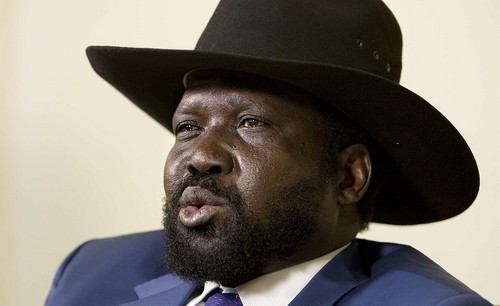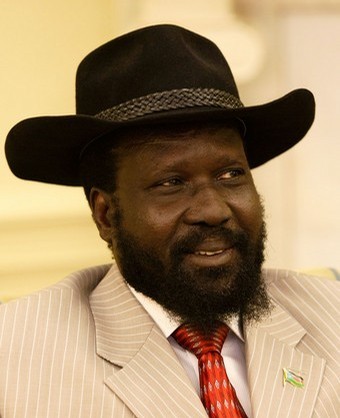Official Stats
- Official Title: President
- Government: Newly established democracy
- Years Left in Office: To 2016; re-election possible
- Political Classification: unknown
- Education:
- Age: 73 (born December 31, 1950)
Salva Kiir Facts and Information
Important Points
- Salva Kiir Mayardit plays an essential role in the unity and functioning of South Sudan.
- Kiir rose up with little to no military knowledge and obtained his power as president after the death of the leader of the Sudan Liberation Movement.
- Kiir worked to make South Sudan independent and was praised for it.
- Kiir started out as an extremely popular president, but has become increasingly disapproved in wake of the conflicts in South Sudan.
- Kiir came into power as a known peacemaker. This has changed due to his actions resulting from extreme circumstances.
The Rundown
Salva Kiir Mayardit is the big kahuna of South Sudan. What could possibly be so great about aman who is best known for his cowboy hat? He’s actually a pretty mysterious dude nobody actually knows exactly when or where he was born, but it is alleged that he was one of the Dinka people, living alongside the Nile River in Southern Sudan, and is 63 (born on December 31,
1950).
Before we get into any details about this guy, let’s get into a little background of Sudan. South Sudan is no friend of North Sudan. Why, you may ask? Well surprise, surprise: religion. The south is mainly Christian while the majority of the north is Muslim. Clearly, both sides thought their religion was best for the state of Sudan, creating animosity between the two regions. This led to a few Civil Wars within the state.
Kiir had great interest in Sudanese politics, and eventually became involved in the late1960s by joining the Anyanya. The Anyanya were a southern Sudanese separatist army formed during the First Sudanese Civil War. Before the signing of the Addis Ababa Agreement in 1972, Kiir had become a lowranking officer. I mean, everyone’s gotta start somewhere, right?
In 1983, Kiir followed the lead of other southern leaders by joining the Sudan People’s Liberation Movement (SPLM) in the Second Civil War. This time around, he came in as the Deputy for Dr. Garang De Mabior (who had advanced military experience with Sudan and the US). Not too bad for a kumbayachanter, huh? It gets better when Kiir assumed the position of head of the SPLA
(SPLM’s military sector) around July, 2005 after Garang’s death. He was also chosen as the First Vice President of Sudan and President of Southern Sudan (not yet a separate state) after former VP Garang’s tragic helicopter death. Now, let’s jump to the 2010 Sudanese election.
Going into the election, Kiir decided not to waste his time going for Sudanese President, but instead shifted his focus to getting reelected as President of Southern Sudan (still not obtained independence just yet). He gained a lot of support during his time as head of the SPLA, predominantly for his loyalty to their vision. He reeled in a whopping 93% of the votes (I believe he may have won this one…). This was seen as “Step One” of the process for seceding from the state of Sudan. He was also reappointed as the First VP of Sudan by Omar alBashir in accordance with the Sudanese constitution. But Kiir was not satisfied just yet.
In January 2011, there was a vote within Southern Sudan on whether or not to claim independence from Sudan. The results came out as more lopsided than Kiir’s reelection vote, at 98.8% voting in favor. On July 9, 2011, South Sudan became an independent state with Kiir at the helm as president. Kiir urged his people “to forgive, though we shall not forget”, referring to the perceived injustices that northern Sudan performed on the newly established state. In October 2011, Kiir applied South Sudan to the EAC (not the East Australian Current, as some of you Finding Nemo viewers would think, but the East African Community).
As you would imagine, Kiir’s presidency has not come without conflict. This is not surprising for the first president of a new state. In his first few weeks at the position, Kiir made it very clear that
human rights violations such as rape performed by armed personnel would be considered criminal acts and be prosecuted. On March 26, 2012, Kiir shied away from his peaceful tendencies with what became known as the Heglig Crisis. The South Sudanese army attacked the Heglig oilfield located in South Kordofan. On September 27 of the same year, Kiir and alBashir signed eight agreements that led to the resumption of oil exports and created a six mile demilitarized zone along their border. On the Second Anniversary of South Sudan’s Independence on July 9, 2013, Kiir gave a speech outlining a program of reforms called to rebuild the state after its wars against the North. The program includes the production of transportation infrastructure that provides alternate routes for oil exports to Uganda, Kenya, and Ethiopia. These new routes will serve to avoid the route going through the hostile North Sudan.
Let us now talk of the current state of conflict within South Sudan. Kiir had a pretty low key first month as president. I mean, he went a month without conflict and rebellion, a WHOLE month! This amazing streak (sarcasm) was ended on August 18, 2011 when up to 600 people were killed and up to 985 people were injured during several cattle raids (yes, cattle). The Murle group stole about 40,000 cattle from the majority Lou Nuer. Starting December 2011, the Nuer Army retaliated by attacking Pibor and surrounding Murle villages. The retaliation took 20,000 to 50,000 lives, as reported by the UN. This was only a small sector of Kiir’s conflict challenges.
The previously mentioned conflicts do not come close to rivaling the challenges that Riek Machar has presented Salva Kiir. Machar has beefed with Kiir even before the new state’s independence in 2011. Machar saw himself as a more fit leader in Southern Sudan than Kiir while Machar was the VP of Southern Sudan from 2011 to his dismissal in 2013. He has gone as far as to call Kiir a dictator. After his dismissal as VP, Machar began his command of rebel forces. His forces took over the cities of Bentiu, Malakal, and Bor. The rebellion’s conflict began in December 2013 and has come to an end (a brief one according to most) due to a peace accord signing between him and Kiir on May 10, 2014. This may have been influenced by the US urging Kiir to reach peace with the rebels after a special envoy into South Sudan on January 31, 2014. We shall see how long this period of peace lasts. Put this one down as to be continued.
So you might be asking yourself why all of this matters. What do I get out of knowing anything else about the man other than his dapper cowboy hat? Sure, South Sudan doesn’t have much cash flow and is pretty far from being advanced but, with its newly established independence, it is now a model of a newly developed state for the interest of the people. If you want continued independence declarations for the preservation of human rights and freedoms (which you should, because this means the preservation of human rights worldwide), then success within
South Sudan is vital. Obviously, Kiir is highly important to the success of South Sudan. Also, heavy conflict within any state affects the whole world. Who knows what kind of UN involvement may be needed if this MacharKiir conflict continues (although a UN military invasion in any African state is very, very unlikely right now). The state also has the potential to at the very least become somewhat successful with its plentiful amount of natural resources. Kiir is not an unreasonable leader. He still does resemble a preference towards peace, just major circumstances have forced him to tend away from it. If there could just be a little less conflict within the state, who knows, maybe he can start doing some great things. And, it is possible that this new MacharKiir peace accord does hold true, which would diminish a lot of South Sudan’s conflict. With his term lasting until 2016 (and possibly lasting past that if reelected), the man may be in office for a pretty long time, giving him the opportunity to head South Sudan toward a positive direction. I still believe in you Salva!
Photos
Translate This Page


